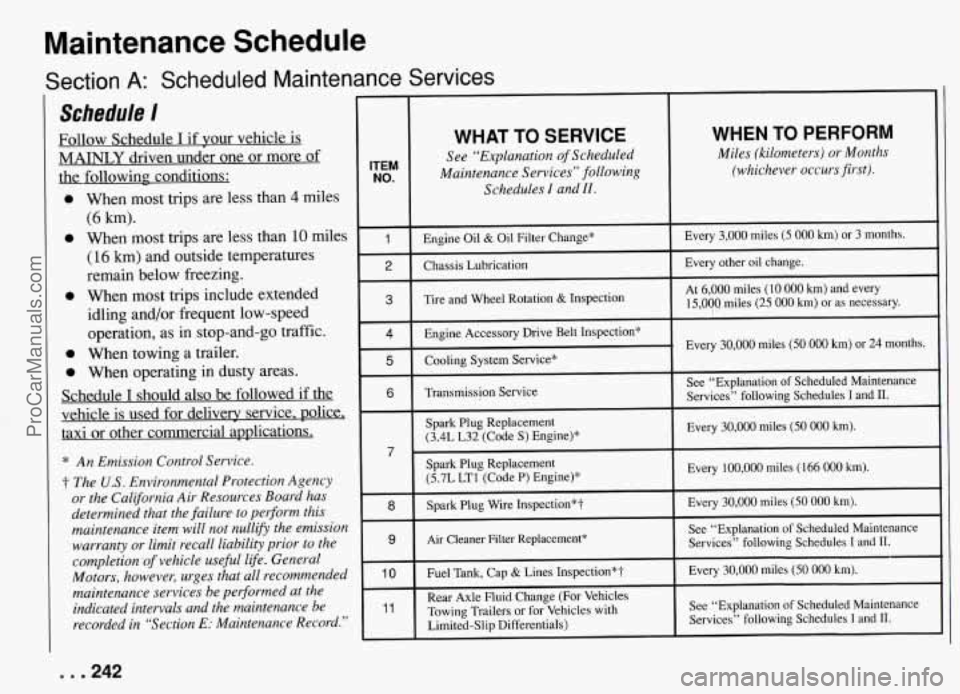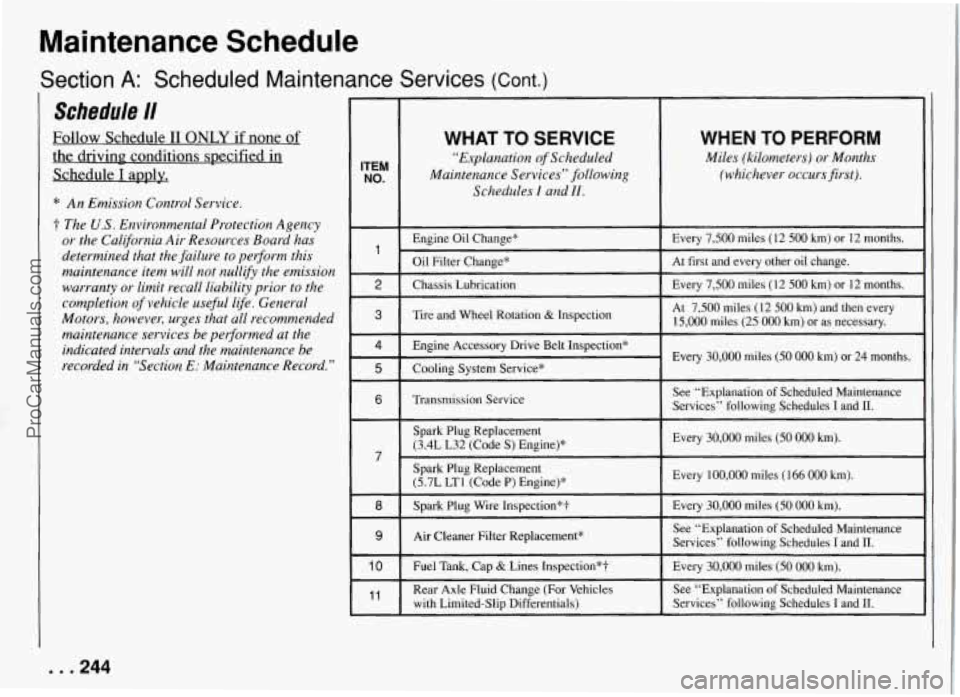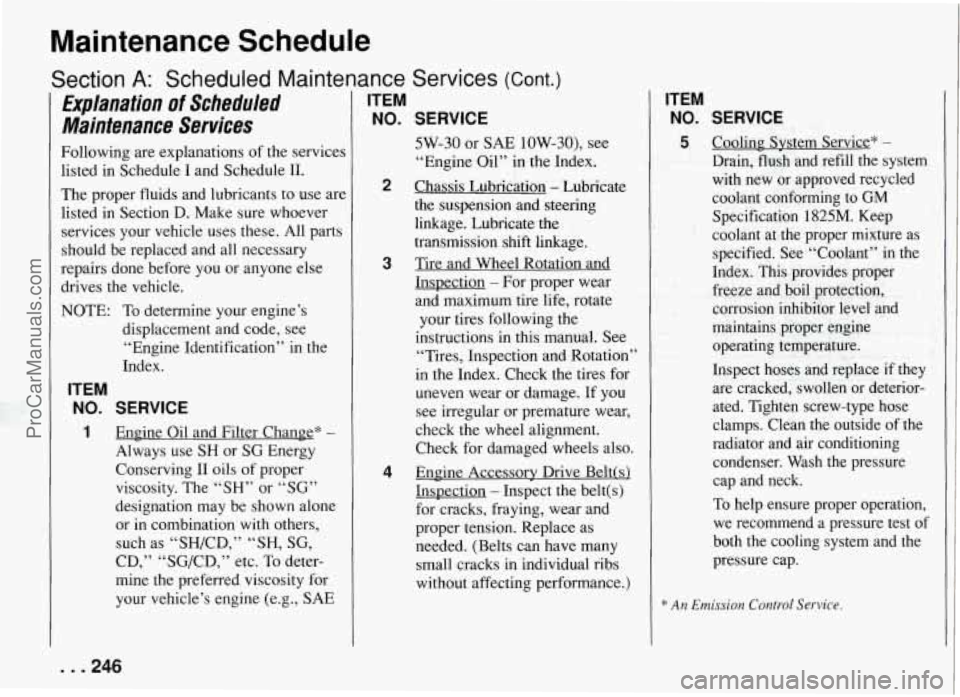engine PONTIAC FIREBIRD 1994 Manual Online
[x] Cancel search | Manufacturer: PONTIAC, Model Year: 1994, Model line: FIREBIRD, Model: PONTIAC FIREBIRD 1994Pages: 290, PDF Size: 14.84 MB
Page 238 of 290

Belt Routing - L32 (Code S) Engine
I
Belt Routing - LTl (Code P) Engine
237. . . ProCarManuals.com
Page 240 of 290

I IMPORTANT
I
KEEP THE ENGINE OIL
AT THE PROPER
LEVEL AND CHANGE AS
RECOMMENDED
This part covers the
maintenance required for your
Pontiac. Your vehicle needs
these services
to retain its
safety, dependability and
emission control performance.
Part 7
Maintenance Schedule
Section
Introduction: A Word about Maintenance ... . . 240
A.
B.
C.
D.
E.
..
Your Vehicle and the Environment ...... .......... 240
How This Part
Is Organized .......... ....... . . 240
Scheduled Maintenance Services .... ................. 242
Using
Your Maintenance Schedules ....................... 241
Selecting the Right Schedule
................ ..... 241
Schedule1
............................... . . 242
Schedule11
................................. . . 244
Explanation
of Scheduled Maintenance Services .......... 246
Owner Checksand Services ................................ 248
AtEachFuelFill
....................................... 248
At Least Once
a Month .................................. 248
At Least Twice a Year
................... ......... 248
At Least Once
a Year ............... .., . . 249
Recommended Fluids and Lubricants ... ................ 253
Maintenance Record ...................................... 255
Periodic Maintenance Inspections .... ... ..... 251
I-
I- -
Have you purchased the GM Protection Plan? The Plan
supplements
your new car warranties.
See
your GM dealer for details.
239. ..
ProCarManuals.com
Page 242 of 290

“Section C: Periodic Maintenance
Inspections” explains important
inspections that your Pontiac dealer’s
service department or another qualified
service center should perform.
“Section
D: Recommended Fluids and
Lubricants” lists some products GM
recommends to help keep your vehicle
properly maintained. These products,
or
their equivalents, should be used whether
you do the work yourself or have it done.
“Section
E: Maintenance Record”
provides a place for you to record the
maintenance perfowed on your vehicle.
Whenever any maintenance is performed,
be
sure to write it down in this section.
This will help you determine when your
next maintenance should be done. In
addition, it is a good idea to keep your
maintenance receipts. They may be
needed to qualify your vehicle for
warranty repairs.
Using Your Maintenance
Schedules
This section tells you the maintenance
services you should have done and when
you should schedule them. Your Pontiac
dealer knows your vehicle best and wants
you to be happy
with it. If you go to your
dealer for your service needs, you’ll know
that GM-trained and supported service
people will perform the work using
genuine GM parts.
These schedules are for vehicles that:
carry passengers and cargo within
recommended limits. You will find
these limits on your vehicle’s
Tire-Loading Information label. See
“Loading Your Vehicle”
in the Index.
are driven on reasonable road surfaces
within legal driving limits.
use the recommended unleaded fuel.
See “Fuel” in the Index.
Selecting the Right Schedule
First you’ll need to decide which of the
two schedules is right for your vehicle.
Here’s how to decide which schedule to
follow:
Schedule
I
Is any one of these true for your vehicle?
Most trips are less than 4 miles (6 km).
Most trips are less than 10 miles (1 6
km) when outside temperatures are
below freezing.
0 The engine is at low speed most of the
time (as
in door-to-door delivery, or in
stop-and-go traffic).
e You operate your vehicle in dusty
e You tow a trailer.
If any one (or more) of these is true for
your driving, follow Schedule
I.
Schedule 11
Follow Schedule I1 QI& if none of the
above conditions is true.
areas.
241 . .
ProCarManuals.com
Page 243 of 290

Maintenance Schedule
C L Section A: Scheduled Maintenance Services
Schedule I
Follow Schedule I if your vehicle is
MAINLY driven under one or more of
the following conditions:
When most trips are less than
4 miles
(6 km).
When most trips are less than
10 miles
(16 km) and outside temperatures
remain below freezing.
When most trips include extended
idling and/or frequent low-speed
operation, as in stop-and-go traffic.
When towing a trailer.
When operating in dusty areas.
Schedule
I should also be followed if the
vehicle is used for delivery service. police,
taxi or other commercial aqdications.
* An Emission Control Service.
t The U.S. Environmental Protection Agency
or the California Air Resources Board has
determined that the failure to perform this
maintenance item will not nullify the emission
warranty
or limit recall liability prior to the
completion ‘of vehicle useful life. General
Motors, however, urges that all recommended
maintenance services be performed at the
indicated intervals and the maintenance be
recorded in “Section
E: Maintenance Record.”
ITEM NO.
-
1
3
-
4
6
-
7
9
11
WHAT TO SERVICE
See “Explanation of Scheduled
Maintenance Services” following
Schedules
I and II.
~
Engine Oil & Oil Filter Change*
Chassis Lubrication
Tire and Wheel Rotation
& Inspection
Engine Accessory Drive Belt Inspection*
Cooling System Service*
Transmission Service
Spark Plug Replacement
(3.4L L32 (Code
S) Engine)*
Spark Plug Replacement
(5.7L LTl (Code P) Engine)*
Spark Plug Wire Inspection*?’
Air Cleaner Filter Replacement*
Fuel Tank, Cap
& Lines Inspeclion*t
Rear Axle Fluid Change (For Vehicles
Towing Trailers or for Vehicles with
Limited-Slip Differentials)
WHEN TO PERFORM
Miles (kilometers) or Months
(whichever occursfirst).
Every 3,000 miles (5 000 km) or 3 months.
Every other oil change.
At
6,000 miles (10 000 km) and every
15,000 miles (25 000 km) or as necessary.
Every
30,000 miles (50 000 km) or 24 months.
See “Explanation of Scheduled Maintenance
Services” following Schedules I and
II.
Every 30,000 miles (50 000 km).
Every 100,000 miles (166 000 km).
Every 30,000 miles (50 000 km).
See “Explanation of Scheduled Maintenance
Services” following Schedules I and 11.
Every 30,000 miles
(50 000 km).
~ ~~ ~~~
See “Explanation of Scheduled Maintenance
Services” following Schedules
I and 11.
. . .242
ProCarManuals.com
Page 245 of 290

Maintenance Schedule
Section A: Scheduled Maintenance Services (Cont.)
Schedule lI
Follow Schedule II ONLY if none of
the driving. conditions specified in
Schedule
I apply.
* An Emission Control Service.
t The US. Environmental Protection Agency
or the California Air Resources Board has
determined that the failure to pedorm this
maintenance item will not nullify the emission
warranty or limit recall liability prior to the
completion
of vehicle useful life. General
Motors, however, urges that all recommended
maintenance services be performed at the
indicated intervals and the maintenance be
recorded in “Section
E: Maintenance Record.”
WHAT TO SERVICE WHEN TO PERFORM
“Explanation of Scheduled Miles (kilometers) or Months ITEM NO. Maintenance Services” following (whichever occursfirst).
Schedules
I and I?.
Engine Oil Change* Every 7,500 miles (12 500 km) or 12 months.
Oil Filter Change* At
first and every other oil change. 1
2 Chassis Lubrication Every 7,500 miles (12 500 km) or 12 months. ~~~
3 I Tire and Wheel Rotation & Inspection I
At 7,500 miles (12 500 km) and then every
15,000 miles (25
000 km) or as necessarv.
4 I Engine Accessory Drive Belt Inspection* ~ Every 30,000 miles (50 000 km) or 24 months.
5 I Cooling System Service* !
6 I Transmission Service I
See “Explanation of Scheduled Maintenance
Services” following Schedules
I and 11.
Spark Plug Replacement
(3.4L L32 (Code
S) Engine)* Every 30,000 miles (50 000 km).
7
I
Spark Plug Replacement
(5.7L LTl (Code P) Ennine)* I Every 100,000 miles (166 000 km). \- I I, I
8 Spark Plug Wire Inspection*? Every 30,000 miles (50 000 km).
9 Air Cleaner Filter Replacement* I I
See “Explanation of Scheduled Maintenance
Services” following Schedules
I and II.
10 Fuel Tank, Cap & Lines Inspection”? Every 30,000 miles (50 000 km).
, , Rear Axle Fluid Change (For Vehicles See “Explanation
of Scheduled Maintenance
with Limited-Slip Differentials) Services” following Schedules I and
11.
. . .244
ProCarManuals.com
Page 247 of 290

Maintenance Schedule
Section A: Scheduled Maintenance Services (Cont.)
Explanation of Scheduled
Maintenance Services
Following are explanations of the services
listed in Schedule I and Schedule
II.
The proper fluids and lubricants to use are
listed in Section
D. Make sure whoever
services your vehicle uses these. All parts
should be replaced and all necessary
repairs done before you or anyone else
drives the vehicle.
NOTE: To determine your engine’s
displacement and code, see
“Engine Identification” in the
Index.
ITEM
NO. SERVICE
1 Engine Oil and Filter Change* -
Always use SH or SG Energy
Conserving
I1 oils of proper
viscosity. The “SH” or “SG”
designation may be shown alone
or in combination with others,
such as “SH/CD,”
“SH, SG,
CD,” “SG/CD,” etc. To deter-
mine the preferred viscosity for
your vehicle’s engine (e.g., SAE
ITEM
NO.
2
3
4
SERVICE
5W-30 or SAE 10W-30), see
“Engine Oil” in the Index.
Chassis Lubrication
- Lubricate
the suspension and steering
linkage. Lubricate the
transmission
shift linkage.
Tire and Wheel Rotation and
InsDection
- For proper wear
and maximum tire life, rotate
your tires following the
instructions in this manual. See
“Tires, Inspection and Rotation”
in the Index. Check the tires for
uneven wear or damage. If you
see irregular or premature wear,
check the wheel alignment.
Check for damaged wheels also.
Engine Accessorv Drive Belt!s)
InsDection
- Inspect the belt(s)
for cracks, fraying, wear and
proper tension. Replace as
needed. (Belts can have many small cracks in individual ribs
without affecting performance.)
ITEM
NO. SERVICE
5 Cooling: System Service* -
Drain, flush and refill the system
with new or approved recycled
coolant conforming to GM
Specification 1825M. Keep
coolant at the proper mixture as specified. See “Coolant”
in the
Index. This provides proper
freeze and boil protection, corrosion inhibitor level and
maintains proper engine operating temperature.
Inspect hoses and replace if they
are cracked, swollen or deterior-
ated. Tighten screw-type hose
clamps. Clean the outside of the
radiator and air conditioning
condenser. Wash the pressure cap and neck.
To help ensure proper operation,
we recommend a pressure test of
both the cooling system and the
pressure cap.
* An Emission Control Service.
. . .246
ProCarManuals.com
Page 249 of 290

Maintenance Schedule
Section B: Owner Checks and Services
Listed below are owner checks and services which should be performed at the intervals specified to help ensure the saf\
ety,
dependability and emission control performance of your vehicle. Be sure any necessary repairs are completed at once.
Whenever any fluids or lubricants are added
to your vehicle, make sure they are the proper ones, as shown in Section D.
At Each Fuel Fill (It is important for you or a service station attendant to perform these underhood checks at each fuel fill.)
CHECK
OR SERVICE
Engine Oil Level
Engine Coolant Level
Windshield Washer
Fluid Level
At least Once a Month
WHAT TO DO
Check the engine oil level and add the proper oil if necessary. See “Engine Oil” in the Index for
further details.
Check the engine coolant level and add the proper coolant mix if necessary. See “Coolant” in
the Index for further details.
Check the windshield washer fluid level in the windshield washer tank and add the proper fluid if
necessary. See “Windshield Washer Fluid” in the Index for further details.
CHECK
OR SERVICE ~~
Tire Inflation
Cassette Deck
WHAT TO DO
Check tire inflation. Make sure they are inflated to the pressures specified on the Tire-Loading
Information label located on the rear edge of the driver’s door. See “Tires”
in the Index for
further details.
Clean cassette deck. Cleaning should be done every
15 hours of tape play. See “Audio Systems”
in the Index for further details.
I At Least Twice a Year ___ ~~~ ~ ~
CHECK
OR SERVICE WHAT TO DO
Hydraulic Clutch
loss in
this system could indicate a problem. Have the system inspected and repaired at once.
System Inspection Check
the fluid level
in the clutch reservoir. See “Hydraulic Clutch Fluid” in the Index. A fluid
. . .248
ProCarManuals.com
Page 250 of 290

I At Least Once a Year I
CHECK
OR SERVICE
Key Lock Cylinders
Body Lubrication
~ ~
Starter Switch
WHAT TO DO
Lubricate the key lock cylinders with the lubricant specified in Section D.
Lubricate all body door hinges. Also lubricate all hinges and latches, including those for the hood,
headlight door assemblies, rear compartment, console doors and any folding seat hardware.
Section
D tells you what to use.
1. Before you start, be sure you have enough room around the vehicle.
2. Firmly apply both the parking brake (see ‘‘Pariung Brake” in the Index if necessary) and the
NOTE:
Do not use the accelerator pedal, and be ready to turn off the engine immediately if it starts.
3. On automatic transmission vehicles, try to start the engine in each gear. The starter should
work only in
“P” (Park) or “N” (Neutral). If the starter works in any other position, your
vehicle needs service.
On manual transmission vehicles, put the shift lever in
“N” (Neutral), push the clutch down
halfway and try to start the engine. The starter should work only when the clutch is pushed
down all the way to the floor. If the starter works when the clutch isn’t pushed all the way
down, your vehicle needs service.
regular
brake.
249. . .
ProCarManuals.com
Page 251 of 290

Maintenance Schedule
Section B: Owner Checks and Services (Cont.)
At least Once a Year (CONK)
CHECK
OR SERVICE
Steering Column Lock
Parking Brake and
Automatic Transmission “P” (Park) Mechanism
Check
Underbody Flushing
WHAT TO DO
While parked, and with the parking brake set, try to turn the key to “LOCK” in each shift lever
position.
With an automatic transmission, the key should turn to “LOCK” only when the shift lever is
0 With a manual transmission, the key should turn to “LOCK” only when the shift lever is in
On vehicles with a key release button, try to turn the key to “LOCK” without pressing the
button. The key should turn to “LOCK” only with the key button depressed. On all vehicles,
the kev should come out only in “LOCK.”
in
“P” (Park).
“R” (Reverse).
brake, set the parking brake.
0 To check the parhng brake: With the engine running and transmission in “N” (Neutral),
slowly remove foot pressure from the regular brake pedal.
Do this until the vehicle is held by
the parking brake only.
brakes.
0 To check the “P” (Park) mechanism’s holding ability: Shift to “P” (Park). Then release all
~~ ~
At least every spring, use plain water to flush any corrosive materials from the underbody. Take
care to clean thoroughly any areas where mud and other debris can collect.
. . .250
ProCarManuals.com
Page 252 of 290

Section C: Periodic Maintenance Inspections
Listed below are inspections and services which should be performed at least twi\
ce a year (for instance, each spring and fall).
You should let your
GM dealer’s service department or other qualified service center do these jobs. Make sure any necessary
repairs are completed at once.
INSPECTION
I OR SERVICE
Restraint Systems
~ ~~~~
Steering and
Suspension Inspection
Exhaust System
Inspection
Inspection
WHAT SHOULD BE DONE
Now and then, make sure all your belts, buckles, latch plates, retractors, anchorages and
reminder systems are working properly. Look for any loose parts or damage. If you see anything
that might keep a restraint system from doing its job, have it repaired.
Inspect the front and rear suspension and steering system for damaged, loose or missing parts,
signs of wear, or lack of lubrication. Inspect the power steering lines and hoses for proper
hookup, binding, leaks, cracks, chafing, etc.
Inspect the complete exhaust system. Inspect the body near the \
exhaust system. Look for broken,
damaged, missing
or out-of-position parts as well as open seams, holes, loose connections or , ’;;
other conditions which could cause a heat build-up in the floor pan or could let exhaust fumes :~
into the vehicle. See “Engine Exhaust’’ in the Index.
Inspect the throttle linkage for interference or binding, and for damaged or missing parts.
Replace parts as needed.
251 . . .
ProCarManuals.com